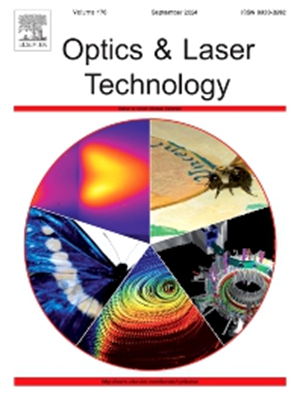Improving room-temperature fretting wear performance of brittle TiAl alloy via laser shock peening without coating
IF 4.6
2区 物理与天体物理
Q1 OPTICS
引用次数: 0
Abstract
To mitigate fretting wear damage in critical high-temperature moving components of aero-engines, such as turbine blades and disks, this study employed LSPwC to treat the surface of TiAl alloys and systematically analyzed their fretting wear behavior and damage mechanisms. The experimental results show that the wear depth of the LSPwCed samples decreased by 43.8% compared to the original samples, while the wear volume increased by 60.4%. After removing the surface remelted layer induced by LSPwC, the wear depth and wear volume decreased by 21.9% and 8.6%, respectively, compared to the original samples. The TiO2/Al2O3 ratio and structural defects such as microcracks and fusion holes in the surface remelted layer formed by LSPwC are the main reasons for the differences in the results. The increase in microhardness induced by LSPwC significantly enhances the overall wear resistance of the material.
无涂层激光冲击强化提高脆性TiAl合金室温微动磨损性能
为了减轻航空发动机关键高温运动部件(如涡轮叶片和圆盘)的微动磨损损伤,本研究采用LSPwC对TiAl合金表面进行了微动磨损处理,系统分析了其微动磨损行为和损伤机理。实验结果表明,与原始试样相比,LSPwCed试样的磨损深度减小了43.8%,而磨损体积增大了60.4%。去除LSPwC诱导的表面重熔层后,磨损深度和磨损体积分别比原始样品减小了21.9%和8.6%。造成结果差异的主要原因是TiO2/Al2O3的比例以及LSPwC表面重熔层中存在的微裂纹和熔孔等结构缺陷。LSPwC引起的显微硬度的提高显著提高了材料的整体耐磨性。
本文章由计算机程序翻译,如有差异,请以英文原文为准。
求助全文
约1分钟内获得全文
求助全文
来源期刊
CiteScore
8.50
自引率
10.00%
发文量
1060
审稿时长
3.4 months
期刊介绍:
Optics & Laser Technology aims to provide a vehicle for the publication of a broad range of high quality research and review papers in those fields of scientific and engineering research appertaining to the development and application of the technology of optics and lasers. Papers describing original work in these areas are submitted to rigorous refereeing prior to acceptance for publication.
The scope of Optics & Laser Technology encompasses, but is not restricted to, the following areas:
•development in all types of lasers
•developments in optoelectronic devices and photonics
•developments in new photonics and optical concepts
•developments in conventional optics, optical instruments and components
•techniques of optical metrology, including interferometry and optical fibre sensors
•LIDAR and other non-contact optical measurement techniques, including optical methods in heat and fluid flow
•applications of lasers to materials processing, optical NDT display (including holography) and optical communication
•research and development in the field of laser safety including studies of hazards resulting from the applications of lasers (laser safety, hazards of laser fume)
•developments in optical computing and optical information processing
•developments in new optical materials
•developments in new optical characterization methods and techniques
•developments in quantum optics
•developments in light assisted micro and nanofabrication methods and techniques
•developments in nanophotonics and biophotonics
•developments in imaging processing and systems

 求助内容:
求助内容: 应助结果提醒方式:
应助结果提醒方式:


